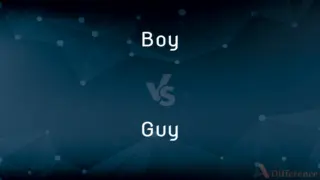Web vs. Flange — What's the Difference?
By Tayyaba Rehman — Updated on November 2, 2023
A web is the central part of a beam that resists shear forces, while a flange is the top and bottom horizontal sections of a beam that resist bending.

Difference Between Web and Flange
Table of Contents
ADVERTISEMENT
Key Differences
The web of a beam forms the vertical section that connects the flanges at the top and bottom. It primarily carries shear loads in a structural element and is thinner than the flanges. The flange is the horizontal, flat section of a beam and is responsible for bearing the bending moments, providing resistance to the beam's top and bottom against compression and tension.
Webs provide stability to the structure, preventing buckling under shear stress. Flanges work in conjunction with the web to distribute forces and moments along the length of the beam. Without a web, flanges alone would be less effective, as they would lack support against lateral forces.
In an I-beam, the web is the slim, vertical centerpiece that can be easily identified, and it usually has a constant thickness. The flanges are the broader, thicker sections at the top and bottom, often where you would attach other elements of a structure. They are designed to be strong in a horizontal plane to provide stability against bending.
A web can be found in various forms of beams, such as I-beams, T-beams, and box beams, always serving the same primary function. Flanges, while also consistent in their purpose, can vary more in width and thickness depending on the design requirements of the structure to ensure it can withstand the expected loads.
In terms of construction, the web is what gives a beam its height and plays a crucial role in determining the overall depth of the beam. The flange is critical in determining the width and can often be seen directly when looking at a bridge or building framework, giving a clue to the strength and design of the beam.
ADVERTISEMENT
Comparison Chart
Position in Beam
Central, vertical connector between flanges
Top and bottom horizontal sections of a beam
Primary Function
Resists shear forces
Resists bending moments
Visual Appearance
Typically thinner and not as wide
Wider and thicker than the web
Structural Stability
Prevents buckling under vertical shear stress
Provides resistance to horizontal bending stress
Construction Variation
Usually uniform thickness across different beams
Can vary in width and thickness for different beams
Compare with Definitions
Web
A network of fine threads spun by a spider.
A dew-covered web glistened in the morning sun.
Flange
A projecting flat rim or collar on an object for strengthening or attachment.
The pipe's flange was bolted to the gasket.
Web
The interconnected system of pages on the Internet.
She spent hours browsing the web for recipes.
Flange
The horizontal section of an I-beam.
Load distribution is mainly the job of the beam's flange.
Web
The central, vertical part of an I-beam.
The steel web was welded to the flanges at the factory.
Flange
The protruding rim at the end of a tool for providing grip.
The flange on the handle provided a secure grip.
Web
The membrane between the toes of a swimmer bird or amphibian.
The duck's web allowed it to paddle efficiently.
Flange
A flange is a protruded ridge, lip or rim, either external or internal, that serves to increase strength (as the flange of an iron beam such as an I-beam or a T-beam); for easy attachment/transfer of contact force with another object (as the flange on the end of a pipe, steam cylinder, etc., or on the lens mount of a camera); or for stabilizing and guiding the movements of a machine or its parts (as the inside flange of a rail car or tram wheel, which keep the wheels from running off the rails). The term "flange" is also used for a kind of tool used to form flanges.
Web
A woven fabric, especially one on a loom or just removed from it.
Flange
A protruding rim, edge, rib, or collar, as on a wheel or a pipe shaft, used to strengthen an object, hold it in place, or attach it to another object.
Web
The structural part of cloth.
Flange
A wide edge on a pillow, placemat, or other fabric object, especially a piece of fabric or ribbon extending from the outer seam.
Web
A latticed or woven structure
A web of palm branches formed the roof of the hut.
Flange
An external or internal rib or rim, used either to add strength or to hold something in place.
Web
A structure of delicate, threadlike filaments characteristically spun by spiders or certain insect larvae.
Flange
The projecting edge of a rigid or semi-rigid component.
Web
Something intricately contrived, especially something that ensnares or entangles
Caught in a web of lies.
Flange
(RPG) An ability in a role-playing game which is not commonly available, overpowered or arbitrarily imposed by the referees.
Web
A complex, interconnected structure or arrangement
A web of telephone wires.
Flange
The vulva.
Web
Often Web The World Wide Web.
Flange
The collective noun for a group of baboons.
Web
A radio or television network.
Flange
The electronic sound distortion produced by a flanger.
Web
A membrane or fold of skin connecting the toes, as of certain amphibians, birds, and mammals.
Flange
(intransitive) To be bent into a flange.
Web
The barbs on each side of the shaft of a bird's feather; a vane.
Flange
To make a flange on; to furnish with a flange; to bend (esp. sheet metal) in the form of a flange.
Web
(Baseball) A piece of leather or leather mesh that fills the space between the thumb and forefinger of a baseball glove. Also called trap1, webbing.
Flange
To mix two copies of together, one delayed by a very short, slowly varying time.
Web
(Architecture) A space or compartment between the ribs or groins of a vault. Also called cell.
Flange
An external or internal rib, or rim, for strength, as the flange of an iron beam; or for a guide, as the flange of a car wheel (see Car wheel.); or for attachment to another object, as the flange on the end of a pipe, steam cylinder, etc.
Web
A metal sheet or plate connecting the heavier sections, ribs, or flanges of a structural element.
Flange
A plate or ring to form a rim at the end of a pipe when fastened to the pipe.
Web
A thin metal plate or strip, as the bit of a key or the blade of a saw.
Flange
To make a flange on; to furnish with a flange.
Web
A large continuous roll of paper, such as newsprint, either in the process of manufacture or as it is fed into a web press.
Flange
To be bent into a flange.
Web
To provide with a web.
Flange
A projection used for strength or for attaching to another object
Web
To cover or envelop with a web.
Flange
An edge used to keep something in place within a rail or track.
The train wheels' flanges kept them on the track.
Web
To ensnare in a web.
Flange
A disk or collar that can be attached to a pipe for decoration or support.
He fitted the decorative flange onto the end of the curtain rod.
Web
The silken structure which a spider builds using silk secreted from the spinnerets at the caudal tip of its abdomen; a spiderweb.
The sunlight glistened in the dew on the web.
Web
(by extension) Any interconnected set of persons, places, or things, which, when diagrammed, resembles a spider's web.
Web
(baseball) The part of a baseball mitt between the forefinger and thumb, the webbing.
He caught the ball in the web.
Web
A latticed or woven structure.
The gazebo’s roof was a web made of thin strips of wood.
Web
(usually with "spin", "weave", or similar verbs) A tall tale with more complexity than a myth or legend.
Careful—she knows how to spin a good web, but don't lean too hard on what she says.
Web
A plot or scheme.
Web
The interconnection between flanges in structural members, increasing the effective lever arm and so the load capacity of the member.
Web
(rail transport) The thinner vertical section of a railway rail between the top (head) and bottom (foot) of the rail.
Web
A fold of tissue connecting the toes of certain birds, or of other animals.
Web
The series of barbs implanted on each side of the shaft of a feather, whether stiff and united together by barbules, as in ordinary feathers, or soft and separate, as in downy feathers.
Web
(manufacturing) A continuous strip of material carried by rollers during processing.
Web
(lithography) A long sheet of paper which is fed from a roll into a printing press, as opposed to individual sheets of paper.
Web
(dated) A band of webbing used to regulate the extension of the hood of a carriage.
Web
A thin metal sheet, plate, or strip, as of lead.
Web
The blade of a sword.
Web
The blade of a saw.
Web
The thin, sharp part of a colter.
Web
The bit of a key.
Web
A major broadcasting network.
Web
(architecture) A section of a groin vault, separated by ribs. en
Web
A cataract of the eye.
Web
Senseid|en|the Web}} {{alternative case form of Web: the World Wide Web.
I found it on the web.
Let me search the web for that.
Web
(intransitive) To construct or form a web.
Web
(transitive) To cover with a web or network.
Web
(transitive) To ensnare or entangle.
Web
(transitive) To provide with a web.
Web
To weave.
Web
A weaver.
Web
That which is woven; a texture; textile fabric; esp., something woven in a loom.
Penelope, for her Ulysses' sake,Devised a web her wooers to deceive.
Not web might be woven, not a shuttle thrown, or penalty of exile.
Web
A whole piece of linen cloth as woven.
Web
The texture of very fine thread spun by a spider for catching insects at its prey; a cobweb.
Web
Fig.: Tissue; texture; complicated fabrication.
The somber spirit of our forefathers, who wove their web of life with hardly a . . . thread of rose-color or gold.
Such has been the perplexing ingenuity of commentators that it is difficult to extricate the truth from the web of conjectures.
Web
A band of webbing used to regulate the extension of the hood.
Web
A thin metal sheet, plate, or strip, as of lead.
And Christians slain roll up in webs of lead.
Web
The blade of a sword.
The sword, whereof the web was steel,Pommel rich stone, hilt gold.
Web
A plate or thin portion, continuous or perforated, connecting stiffening ribs or flanges, or other parts of an object.
Web
The blade of a saw.
Web
The thin vertical plate or portion connecting the upper and lower flanges of an lower flanges of an iron girder, rolled beam, or railroad rail.
Web
Pterygium; - called also webeye.
Web
The thin, sharp part of a colter.
Web
A disk or solid construction serving, instead of spokes, for connecting the rim and hub, in some kinds of car wheels, sheaves, etc.
Web
The membrane which unites the fingers or toes, either at their bases, as in man, or for a greater part of their length, as in many water birds and amphibians.
Web
The bit of a key.
Web
The arm of a crank between the shaft and the wrist.
Web
The series of barbs implanted on each side of the shaft of a feather, whether stiff and united together by barbules, as in ordinary feathers, or soft and separate, as in downy feathers. See Feather.
Web
The part of a blackmith's anvil between the face and the foot.
Web
The world-wide web; - usually referred to as the web.
Web
To unite or surround with a web, or as if with a web; to envelop; to entangle.
Web
An intricate network suggesting something that was formed by weaving or interweaving;
The trees cast a delicate web of shadows over the lawn
Web
An intricate trap that entangles or ensnares its victim
Web
The flattened weblike part of a feather consisting of a series of barbs on either side of the shaft
Web
An interconnected system of things or people;
He owned a network of shops
Retirement meant dropping out of a whole network of people who had been part of my life
Tangled in a web of cloth
Web
Computer network consisting of a collection of internet sites that offer text and graphics and sound and animation resources through the hypertext transfer protocol
Web
A fabric (especially a fabric in the process of being woven)
Web
Membrane connecting the toes of some aquatic birds and mammals
Web
Construct or form a web, as if by weaving
Web
A complex system or network with many connections.
The investigation revealed a web of corruption.
Common Curiosities
Is the web important for a beam's strength?
Absolutely, it contributes significantly to a beam's ability to withstand shear stress.
What materials are flanges made from?
Flanges are typically made from steel, stainless steel, aluminum, or plastic.
Can a flange be used for connections?
Yes, flanges are often used to connect pipes, tubes, or beams.
Can the web of a beam be hollow?
Yes, box beams have a hollow web.
Are flanges always circular?
No, they can be circular, square, or other shapes depending on their use.
Are webs only found in beams?
In construction, yes, but "web" can also refer to other structures like a spider's web or a webbed foot.
Is a flange part of a beam or added separately?
It is part of the beam, running along the top and bottom lengths of an I-beam.
What does "web" mean in construction?
It's the central part of a beam that connects the horizontal flanges and resists shear forces.
Do web and flange sizes vary by industry?
Yes, the size and specifications will vary based on industry and application.
How do you choose the right flange size?
Flange size is based on the requirements of the connection, like the diameter of the pipe.
Do flanges need to be welded?
They can be welded, bolted, or screwed, depending on the application.
Can a web be too thin?
Yes, if too thin, it can fail under shear stress or buckle.
What is web buckling?
It's a failure mode where the web of a beam deforms under compressive shear stress.
Are there standards for flange manufacturing?
Yes, there are international standards like the ANSI and ISO.
Can the terms "web" and "flange" refer to the same part of a beam?
No, they refer to different parts, with the web being vertical and the flange being horizontal.
Share Your Discovery

Previous Comparison
Boy vs. Guy
Next Comparison
Potential vs. PossibleAuthor Spotlight
Written by
Tayyaba RehmanTayyaba Rehman is a distinguished writer, currently serving as a primary contributor to askdifference.com. As a researcher in semantics and etymology, Tayyaba's passion for the complexity of languages and their distinctions has found a perfect home on the platform. Tayyaba delves into the intricacies of language, distinguishing between commonly confused words and phrases, thereby providing clarity for readers worldwide.















































